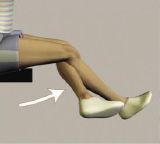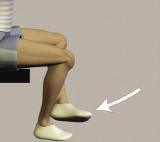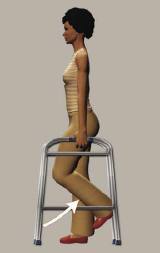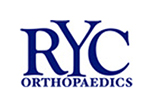Total Knee Replacement Patients
You will experience swelling in the joint. The swelling will be reabsorbed by your body over time, especially as you develop adequate muscle strength. You may have bruising in the operated leg as well. This may travel down the leg with gravity.
Dressing: The dressing typically is removed 3 days after surgery. If there is still drainage, a new dressing will be applied and changed daily until the drainage stops. You can get the incision wet with showering after 3 days. Dab a towel over the incision to dry. No bathing for 4 weeks after surgery.
Incision: Staples should be removed 10-14 days after surgery. If you are discharged to a rehab facility from the hospital, the staples will be removed by the staff there. If you are discharged to your home, your visiting nurse will remove the staples at home.
Medications: The injectable blood thinner should be continued for 2 weeks after surgery. Once completed, take an aspirin daily for another 2 weeks. Resume all home meds after surgery. If you are given narcotic pain medicine, take a stool softener twice day.
Ice Machine: If you are interested in an ice machine, please contact the office. If you do not use an ice machine, use ice packs to control the pain and swelling. Do not put the ice directly on the skin. Use ice for 20 minutes at a time, 3-5 times a day.
Physical Therapy: Please contact the office for an outpatient physical therapy prescription as soon as you are 1) discharged from your rehabilitation facility, or 2) discharged from your visiting physical therapist at home. If you are unhappy with your physical therapy visits to your home, do not hesitate to contact the office to begin outpatient physical therapy immediately.
Exercises: Never place a pillow under the operated knee. Please place a towel roll under the ankle and work on achieving full extension during the first week after surgery. Other exercises that may be performed are shown below. Our goal is for you to achieve 90 degrees of flexion and full extension by your first post-op visit.
CPM: Continuous passive machines are optional. Please contact our office if you would like to receive a CPM machine at home.
Driving: You will discuss when you can drive with your surgeon. Generally, driving begins 4-6 wks after surgery. You should be completely off your pain meds to drive.
Follow-up: Your follow-up visit will be 4 weeks after surgery.

Knee-straightening exercises: Place a small, rolled up towel under your leg just above your heel so that your heel is not touching the bed. Tighten your thigh. Try to fully straighten your knee and to touch the back of your knee to the bed. Hold fully straightened for 5 to 10 seconds. Repeat until your thigh feels fatigued.
Sitting supported knee bends: Sit on a bed or chair with your thighs supported. Alternately straighten and bend your knee, using the foot of your unoperated leg to push your operated leg up (left-hand illustration) and back (right) as far you can. Hold your knee in the full bent/straightened position for 5 to 10 seconds. Repeat several times until your leg feels fatigued or until you can completely bend and straighten your knee.



Sitting unsupported knee bends: Sit on a bed or chair with your thighs supported. Bend your knee as far as you can until your foot rests on the floor. With your foot lightly resting on the floor, slide your upper body forward in the chair to increase
Your knee bend. Hold for 5 to 10 seconds. Straighten your knee fully. Repeat several times until your leg feels fatigued or until you can completely bend your knee.

Bed-supported knee bends: Bend your knee as much as possible while sliding your foot on the bed. Hold your knee in a maximally bent position for 5 to 10 seconds and then straighten. Repeat several times until your leg feels fatigued or until you an cCompletely bend your knee.
Advanced exercises and activities
A full recovery will take time. The pain from your problem knee before your surgery and the pain and swelling after surgery have weakened your knee muscles. The following exercises and activities will help your knee muscles recover fully.
Standing knee bends: Standing erect with the aid of a walker or crutches, lift your thigh and bend your knee as much as you can. Hold for 5 to 10 seconds. Then straighten your knee, touching the floor with your heel first. Repeat several times until fatigued.


Assisted knee bends: Lying on your back, place a folded towel over your operated knee and drop the towel to your foot. Bend your knee and apply gentle pressure through the towel to increase the bend. Hold for 5 to 10 seconds. Repeat several times until fatigued.
Knee exercises with resistance: You can perform any of the early or advanced exercises with light weights around your ankle. (Inexpensive wraparound ankle weights with Velcro straps can be purchased at most sporting goods stores.) These resistance exercises usually can begin four to six weeks after your surgery. Use one- to two-pound weights at first; gradually increase the weight as your strength returns.
Stationary bicycle exercise: Exercising on a stationary bicycle is an excellent activity to help you regain muscle strength and knee mobility. Adjust the seat height so that the bottom of your foot just touches the pedal with your knee almost straight. Pedal backwards at first. Pedal forward only after a comfortable backwards cycling motion is possible. As you become stronger (at about 4 to 6 weeks) slowly increase the tension on the pedals. Pedal forward 10 to 15 minutes twice a day, gradually building up to 20 to 30 minutes 3 to 4 times a week.





